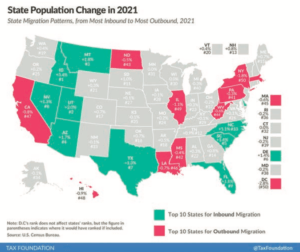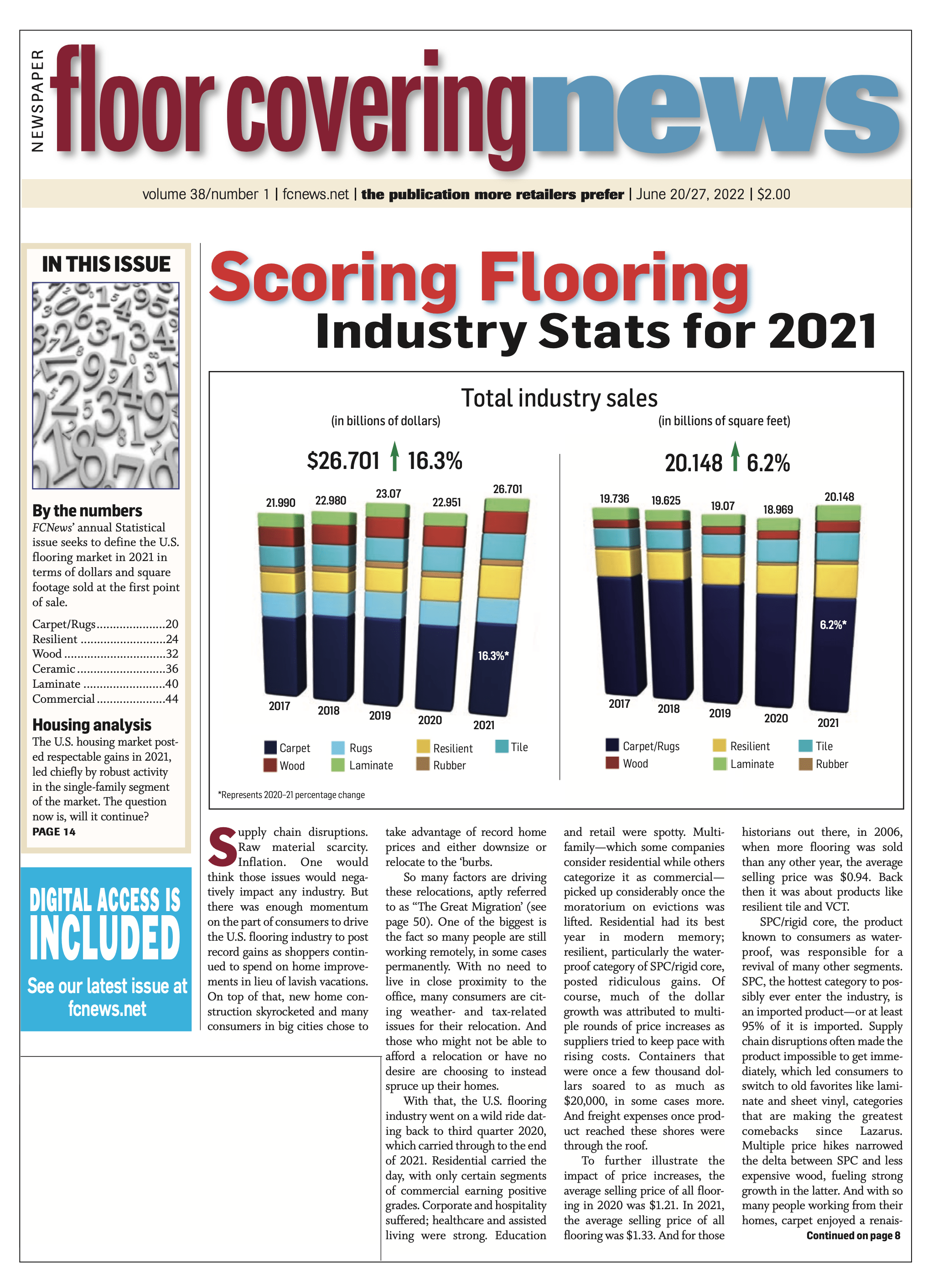Newly released information from the U.S. Census Bureau confirms that the population shifts that began in the immediate aftermath of the COVID-19 pandemic not only persists today but is also gaining momentum.
That’s according to recent U.S. Census Bureau article, “New Data Reveal Most Populous Cities Experienced Some of the Largest Decreases,” in which the authors—Amel Toukabri and Crystal Delbe— discuss the “great migration” phenomenon at length. The report shows evidence that between 2020-2021, U.S. residents fled cities like New York, San Francisco, Boston and Washington D.C. and moved to states like Texas, Arizona and Florida.
Following are excerpts from this article. (Editor’s note: Some content has been edited for content and style.)

While the COVID-19 pandemic has not officially ended, the U.S. Census Bureau’s first release of population estimates for cities and towns this decade reveals how population growth trends shifted during the first year of the pandemic. Some of the fastest-growing cities before the pandemic grew at a much slower rate after it started, changing the rankings among the top 15 gainers. While many rankings of cities and towns remained roughly the same, there were notable differences in the magnitudes of change.
The new estimates show some fast-growing cities in 2019 grew at a slower rate in 2021. At the same time, others grew at a faster pace during the pandemic. Overall, growth slowed in the nation’s biggest cities and some states experienced an uptick in population due to migration to the South and West in the first year after the pandemic hit.
As of July 1, 2021, six of the top 15 fastest-growing cities/towns with populations of 50,000 or more were also among the top fastest growing in the pre-pandemic July 1, 2019. While the list was mostly similar, growth slowed for some. For example, Leander, Texas, top-ranked in 2019 with a 12% increase from 2018, slipped to second place with a 10.1% growth from 2020 to 2021. In Idaho, the city of Meridian’s growth fell from 7.2% in 2019 to 5.2% in 2021, slipping from sixth to 13th place.
San Francisco was not among the 15 fastest-declining cities in 2019, but it topped the list in 2021 with a 6.3% drop in population from the previous year, research shows. Six of the cities on the declining list in 2021 were in California. In Cupertino, one of the 15 fastest-declining in both 2019 and 2021, the magnitude of the drop in its population growth rate nearly tripled. Meanwhile, major cities on the East Coast, including Boston and Washington, D.C., also made the list of the cities seeing the fastest population declines. The rates of population decline of 5% or more in a single year were nearly unprecedented, according to Census Bureau statistics.
Overall, the pre-pandemic population losses from 2018 to 2019 were much lower than after the pandemic hit. For instance, Petaluma, Calif., had the largest percentage population decline from July 1, 2018, to July 1, 2019, a drop of 2.1%. But that drop would not even have ranked among the top 15 in 2020-21, after the start of the pandemic.
One year into the pandemic, Phoenix—the city with the largest numerical increase from 2018 to 2019—moved into second place, switching spots with San Antonio. Its population gain of 13,626 was roughly half what it had added in 2019. In addition, San Antonio and Fort Worth, Texas; and Meridian, Idaho, while still among the 15 cities with the largest numerical increases, all showed notably smaller increases. Collectively, the total population increase for the nation’s 15 largest-gaining cities was a little over 187,100 people before the pandemic hit compared to about 129,000 a year into it.
While New York City remained the city with the largest numerical decrease, its population decline in 2021 (305,465) was nearly six times its numerical decrease in 2019 (53,624). Chicago, which ranked third with a decrease of 45,175 in 2021, saw its population drop by only 7,447 (six times less) in 2019. All told, the cities with the largest numerical drop in population had a combined loss of nearly 609,800 a year into the pandemic compared to about 102,700 between 2018 and 2019.
Not all migration shifts were due to the pandemic, however. Population declines can also result from a variety of causes, including natural dis- asters such as hurricanes and wildfires. For example, Hurricane Laura, a destructive Category 4 hurricane in August 2020, is believed to have contributed to the population losses of Lake Charles, La., the second-fastest declining city with a decrease of 5% from 2020 to 2021.
Behind the Great Migration
Domestic migration is defined by the U.S. Census Bureau as the movement of populations that occurs during specified periods of time. When it comes to the 2020-2021 migration period, a good portion of these population changes can be attributed to the novel coronavirus pandemic—which resulted in 58% of counties across the United States experiencing population growth.
Anecdotal FCNews research shows that despite being two years removed from the start of the pandemic, Americans are still finding themselves fleeing the big cities for more spacious, suburban environs.
“One of the largest local real estate companies reported to me that about 50% of their current suburban buyers are coming from the city,” said Lauren Voit, owner of Great Western Flooring, Naperville, Ill., located about 35 miles from Chicago. “As people move out of the city, I see our surrounding area attracting many new homeowners. We see this trend as a huge opportunity for us.”
Similarly, Mike Foulk, owner of Foulk’s Flooring America in Meadville, Pa. said his centrally located store in western Pennsylvania is in the perfect spot to capitalize on customers coming from the big surrounding cities. “The trend of people moving to areas with lower costs of living will definitely help us dealers that are located in small town America,” he said. “We are 90 miles from three major cities. People are not far from large city culture but [they are close] enough where the lifestyle is affordable.”
Out in the Pacific Northwest, the story is much the same. “We are in a sweet spot and we count our blessings,” said Don Cantor, owner of Lake Interiors in Chelan. He said the migration from urban to suburban areas will continue as the pandemic normalized the work-from-home culture and that it’s more likely for the new generation of workers to desire less expensive homes in smaller cities or the luxury of having more space in smaller towns. “I have spoken with some of these Microsoft and Amazon employees; they can now work from home, which saves them two and a half hours each way. It’s a more efficient way of life for them.”
A Zillow survey conducted by Harris found that more than half of Americans have had a chance at working remotely during the pandemic and that 75% of them would prefer to continue working remotely, even if it’s only part time. What’s more, the survey also concluded that those remote workers would also consider moving farther from their place of employment to search for a more spacious home that can accommodate a home office area.
While this shift from urban to suburban areas resulted in new business opportunities for floor covering retailers, business owners also found themselves upgrading their spaces to accommodate the influx of customers. “We are witnessing a continuous increase in consumers’ desire to shop for flooring specific to the new functionality needs of their homes and families,” said Mindy Arnette, residential sales manager of Brians Flooring & Design in Birmingham, Ala. “We expect the multifunctional home design will dictate [the pace of] our flooring sales.”
Methodology
Unlike the decennial census, which aims to count every per- son living in the United States, the annual population and housing unit estimates for states, counties, cities and
towns are developed using various administrative data sources, such as birth and death certificates and tax return statistics on people who changed residences. The decennial census serves as a starting point for each decade of sub-county population estimates.
Cities and towns are more likely than larger geographies to annex land or disincorporate. The Census Bureau applies these types of legal boundary changes to the decennial census to create an updated base for population and housing units. Such geographic updates are made annually, so that each new time series of estimates the agency produces begins from a newly updated geographic base. This “estimates base” created from the census is essential to accurately distributing the population.

